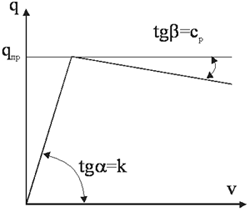
Field experience demonstrates that thermal expansion and internal pressure generate compressive forces that can cause significant upward buckling in buried pipelines, including surface emergence. Therefore, both straight and curved buried sections require stability verification. Backfill soil weight provides beneficial restraint against upward displacement.
Consider a buried pipeline with initial curvature (Fig. 1) subject to equivalent compressive force S from thermal and pressure effects. The soil resistance to lateral displacement follows the model in Fig. 2.

Fig. 1

Fig. 2
Analysis methods follow A.B. Ainbinder's methodology from [1], incorporating conservative assumptions and safety margins.
The approximate energy method analyzes total system energy, making results sensitive to assumed buckling shape.
Initial pipeline curvature is assumed to match the buckling shape.
For vertical buckling, soil beneath the pipe is considered rigid. Buckling shapes are:
Initial curvature -  ,
additional deflection -
,
additional deflection -  .
.
For horizontal buckling, soil stiffness is equal on both sides. Equations become:
Initial curvature -  ,
additional deflection -
,
additional deflection -  .
.
This model applies to small bend angles (acute angle α between adjacent straight sections) – up to 10 degrees.
Soil elastic properties are neglected for critical longitudinal force calculation. Soil behaves elastically along the buckling length, characterized by allowable lateral resistance qlong and pressure-balance coefficient Cpb. Additional stability checks incorporate soil elasticity.
For inclined initial curvature planes, initial deflection components are resolved into vertical and horizontal directions. START-PROF uses inclination angle φ from the horizontal plane (angle between bend plane and vertical perpendicular plane).
Stability verification uses four conditions:
 ; ; |
(1) |
 ; ; |
(2) |
 ; ; |
(3) |
 . . |
(4) |
where m – service condition factor (0.9 for RD 10-400-01; varies by pipeline category for SNIP 2.05.06-85);
 ,
, - equivalent forces including curvature
self-compensation effects, calculated separately for vertical and horizontal
planes;
- equivalent forces including curvature
self-compensation effects, calculated separately for vertical and horizontal
planes;
 - equivalent force excluding curvature
self-compensation;
- equivalent force excluding curvature
self-compensation;
 ,
, - critical forces accounting for initial
curvature and nonlinear soil resistance in vertical and horizontal planes;
- critical forces accounting for initial
curvature and nonlinear soil resistance in vertical and horizontal planes;
 ,
, - critical forces for straight compressed
rods in linear-elastic medium.
- critical forces for straight compressed
rods in linear-elastic medium.
For , soil stiffness is equal on both sides;
for
, soil stiffness is equal on both sides;
for  backfill
stiffness is significantly lower than native soil stiffness.
backfill
stiffness is significantly lower than native soil stiffness.  is the critical force per RD 10-400-01.
For bend angles exceeding 10 degrees,
methodology [1]
does not apply, and analysis uses
only the last three conditions.
is the critical force per RD 10-400-01.
For bend angles exceeding 10 degrees,
methodology [1]
does not apply, and analysis uses
only the last three conditions.
For bend angles over 10 degrees, stability check using formula (1) is omitted (methodology inapplicable). Analysis continues using formulas (2), (3) and (4).
1. Aynbinder A.B., Kamerstein A.G. Transmission Pipeline Stress and Buckling Analysis. Moscow, 1982